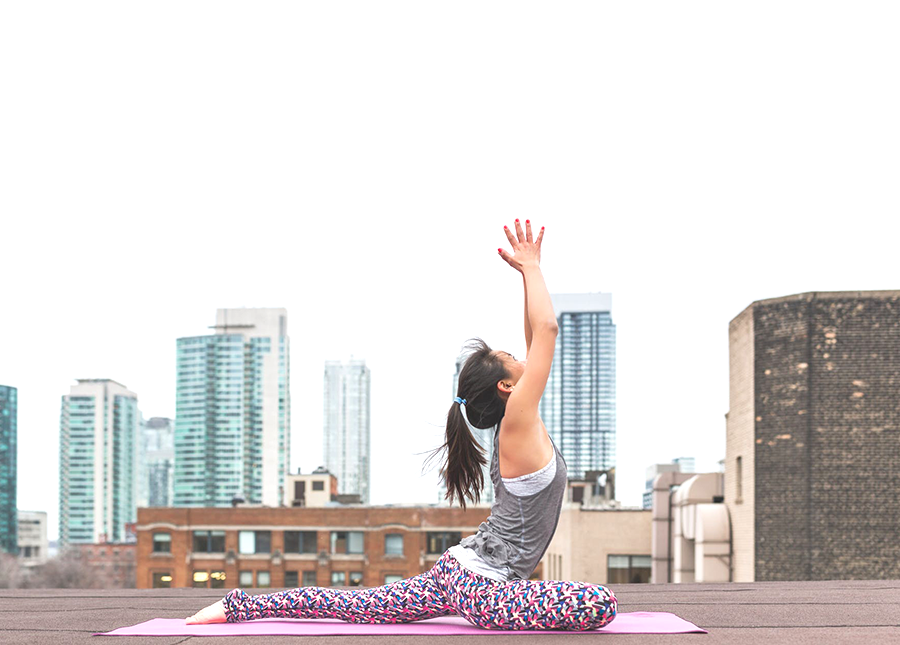7 Ways To Seamlessly Fit A Workout Routine Into Your Busy Schedule

Before I had a solid fitness routine in place, I was a textbook “weekend warrior.” On Saturday and Sunday, I’d go for really long runs or hit the gym hard. But then Monday through Friday, my only exercise consisted of walking from my car to my desk at 8 AM, and from my desk to my car at 5 pm. Needless to say, it wasn’t ideal. Not only that, it wasn’t sustainable. I’d end up injuring myself during one of my warrior weekends and be out of commission for weeks.
The Canadian Society for Exercise Physiology (CSEP) says we should be clocking 2.5 hours a week of moderate to vigorous aerobic activity to stay physically and mentally healthy. The same guidelines say we should be adding in muscle strengthening exercises at least twice a week. Its next to impossible to fit all that into a weekend and is likely to result in injury and a disenchantment with exercise in general.
Don’t get me wrong — exercising on the weekends is still way better than not exercising at all. But it doesn’t make up for sitting on your duff all workweek long. There’s really no way around it. Weekend warrior or not, it’s best to find a way to work in exercise at least twice during your work week. But establishing a fitness routine for your work week isn’t a big deal as long as you have a good strategy. Here are some of my best tips for making it work:
1. Focus on forming the habit first
If you’re not used to exercising on workdays, your first priority is to find a way to actually do it. The quality and duration of your workouts at this point is secondary. When we get that coveted burst of motivation, the tendency is to hit the ground running, both literally and figuratively. But be careful with this, because while being motivated is great, it can cause you to be a bit overzealous. If you start pounding out three miles every morning before work after six months of zero exercise, you’re soon going to get hurt and discouraged.
Take it from me. I’m still not quite recovered from an injury that occurred over a year ago, after attempting an overly ambitious pose in yoga class!
Forming new habits can take longer than you think. That’s why it’s crucial you focus on the habit itself rather than results in order to keep from getting discouraged. You may have heard the popular myth that it takes 21 days to form a new habit. Unfortunately, this is not entirely true. Scientifically, the average time to form a new habit is closer to two months, and even that’s not a hard rule. The reality is that there’s no magical number of days before something becomes a habit, because everyone is different! It’s important to understand this so that you don’t feel discouraged and give up when on the 22nd day you aren’t leaping out of bed at 5 AM to exercise on autopilot.
2. Turn your commute into exercise
If you’re fortunate to live close enough to your office, experiment with biking to work. Granted, this takes a little extra planning and organization. But if you can make it work, biking to work has many advantages. Not only will you get a good workout, you’ll save money on gas, and it’s environmentally friendly to boot! Try a test run on a Saturday for an idea of how long it will take to get there. Depending on the distance and climate, you might be able to get away with biking to work in your work clothes. But in hotter weather, bringing a change of clothes may be wise!
Again, start slow and bike to work one or two days a week. You can increase the frequency as your body adjusts, and save the car for those rainy (or snowy!) days.
3. Make physical activity a part of your workday
It’s important that your fitness routine includes activity throughout your workday. Studies indicates that eight hours of sitting every day is frighteningly unhealthy, even if you exercise. Set your Outlook calendar to remind you every hour to get up and walk around. Take the stairs to and form your office instead of the elevator. Instead of holding your next department meeting in the board room, take your colleagues for a brisk walk around the block to discuss the topic at hand and bounce ideas off each other. They seem like small, silly things, but the can make a huge difference to your health and longevity!
4. Try shorter sessions, more often
While some studies seem to indicate that it doesn’t matter how you divvy up your 2.5 hours, spreading out your sessions can make them easier to fit into your schedule. After all, no matter how busy you are, you can find 10-15 minutes to exercise. (Let’s face it — you probably spend more than 20 minutes at the Starbucks drive thru waiting for your latte! I know I do!) And yes, science supports that such short sessions can make a positive impact on your health and fitness levels.
To make the most of these sessions, fill them with maximum-effort exercises. HIIT is perfect for this! A quick search on Pinterest for “HIIT” will yield hundreds of quick, effective workouts that you can do anywhere. If you need something more structured, check out this review on the Bodyboss Method, an HIIT program I’ve completed that yielded fantastic results. You can save your longer sessions for steady state cardio like running or cycling. But if you’re new to cardio, start with 15-20 minutes and ease into longer sessions. I find I have the best results and fewest injuries sticking to sessions that are no longer than 40 minutes.
5. Seriously consider early morning workouts
In my opinion, mornings are by far the best time of day to exercise. A lot of people are really resistant to AM workouts, and I get it. Mornings tend to be enough of an undertaking by themselves without throwing a circuit of burpees into them. But if you can get over the hurdle of waking up a little earlier, there are some serious benefits to the AM workout:
- You’re “eating the frog.” In other words, you’re getting your workout out of the way first thing so you can focus on the rest of your day. Because exercise is the first thing on your to-do list, it’s far less likely to get trumped by other things on your schedule.
- You’re making the most of the Excess Post-exercise Oyxgen Consumption effect (aka EPOC). In plain English, you’re effectively boosting your metabolism to burn more calories for hours *after* you finish exercising!
- Finishing a workout before work gives you a feeling of accomplishment, which is a huge mood booster. Personally, I’m in a better mood and even more productive on the days I exercise before work.
Getting up a little earlier doesn’t have to be that bad. Plan out your mornings the night before so that you aren’t wasting time searching for your outfit or making a lunch. And remember, shorter sessions are still great! I’m telling you, get those 10-15 minutes in before 7 am, and marvel at how it transforms your day!
6. Experiment with other times to work out
Everyone is different, and a fitness routine that works for one person might not work for the next. If mornings are absolutely not for you for some reason, then the other two logical times for the nine-to-fiver is either the lunch break or after work.
The lunch break exercise session can be viewed as the best of both worlds. You don’t have to wake up early or make any changes to your evening schedule. It does take some extra strategy and organization, but can work in a pinch. I’ve gotten in a 20-minute workout and then still had time to freshen up, pick up some lunch, and get back to my desk before the hour is up. But it’s not ideal if you’re doing high intensity exercises where you get really sweaty, or if you want to incorporate a longer workout. Plus, depending on the nature of your job, there’s an increased risk of something coming up at work that totally derails your chance to workout (or even take a lunch break at all).
Evening workouts are the last option, and in my experience, the least effective time to incorporate a fitness routine. There’s a mental fatigue that tends to take hold by the end of the day, which makes me less likely to stick to the plan. If this is the only time you can exercise, I would recommend going straight to the gym from work without going home first. If you work out at home, keep your workout clothes/shoes by the front door so you can grab them and put them on as soon as you get in. And just know that if your tush so much as touches that couch, your plan to workout will go right out the window!
7. Make Your Fitness Routine Non-Negotiable
You aren’t going to just stumble into your workout gear and find yourself holding a barbell. In order to make your fitness routine work, you need to hold yourself accountable for sticking to the plan. You have to fully commit to these times the same way you would your most important obligations.
Think about when you wake up for work. Sure, you’d much rather sleep in instead of getting up at the crack of dawn to go to your job. But you don’t say, “Maybe tomorrow I’ll get up and try to go to work then.” You get your butt out of bed and go to work, because you’re committed.
*****
Finding your reasons for this commitment to a fitness routine is a whole other topic. But a good place to start is by thinking about what’s important to you about exercise. Then choose some goals to shoot for and write them down. Refer back to these goals whenever you need a burst of motivation!
Corrie Alexander is a content creator and customer service manager from Toronto, Ontario. Her climb up the corporate ladder cultivated her interest in the topic of career development, a passion rivaled only by her love of exercise and strong coffee. Visit her website, thefitcareerist.com, and follow her on Twitter here.
Image via Pexels




